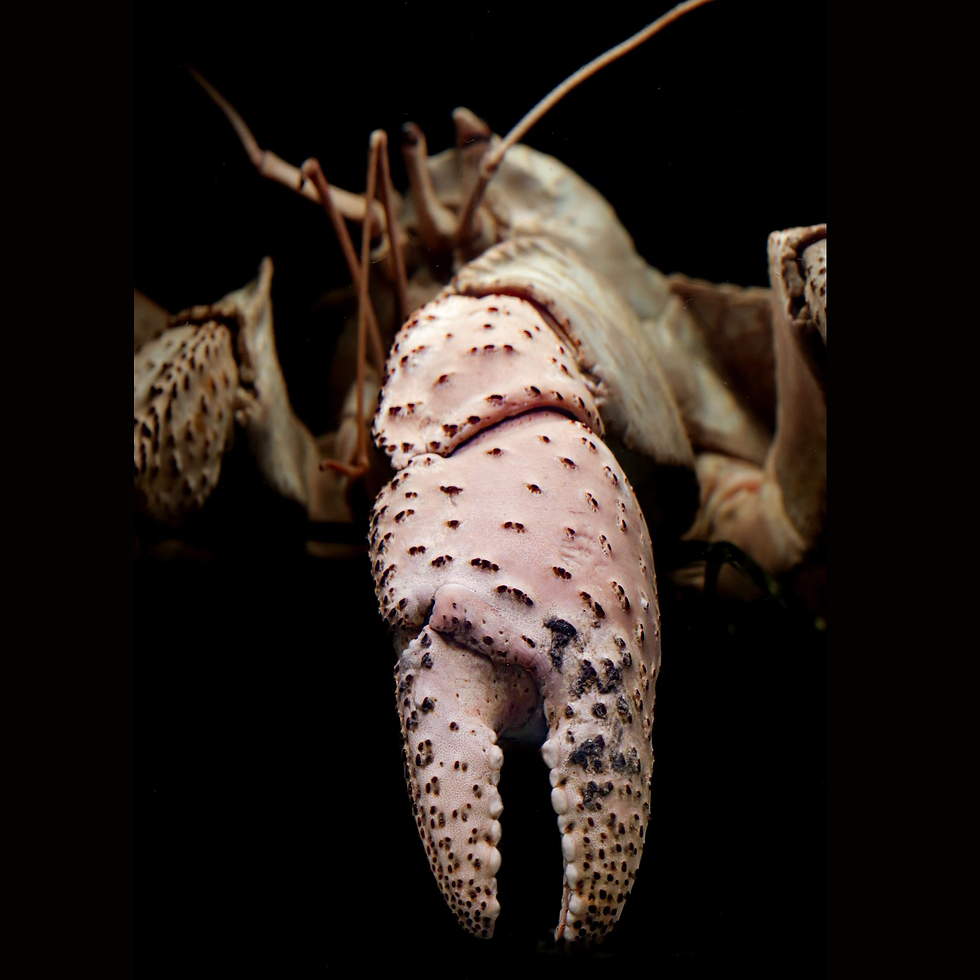Specimen Showcase|The Secret Life of Robber Crab 🕵️♀️
- Hong Kong Biodiversity Museum

- Mar 10
- 4 min read
You are most likely familiar with hermit crabs, living in small shells and carrying their home around. Not all hermit crabs, however, are small and one species found on islands across the Indian and the Central Pacific Oceans, is massive, especially for an arthropod species. This invertebrate giant is the coconut crab 𝘉𝘪𝘳𝘨𝘶𝘴 𝘭𝘢𝘵𝘳𝘰 (Linnaeus, 1767), also known as the robber crab🦀. Coconut crabs spend all their adult life on land and are considered the largest crustacean in the world, with a Guinness World Record to prove it! They are truly spectacular with an average weight that may exceed 4 kg, measure up to a meter across and live 40 to 60 years in the wild!

Growing big allows coconut crabs to develop some rare talents. True to their name they can use their front pair of claws to crack green coconuts or other fruits and seeds to obtain the lipid and sugar rich flesh🥥. Their first two pairs of fore curved-end walking legs have an inward grip allowing them to climb up coconut trees up to 6 meters high🌴! With an excellent sense of smell, they can also detect odors over long distances. They have specialized organs called aesthetascs on their antennae to help them determine the concentration and direction of the smell. Therefore, when they flick their antennae, odor reception is enhanced allowing them to detect fruit, nuts, and even rotten meat. Their mighty claws are also powerful weapons for catching prey such as crabs for instance. Not only are their claws strong enough to lift 30 kg of rocks, but observations revealed their ability to also attack even vertebrates like birds, rats, or tortoise’s eggs or hatchlings at night. Their heavy weight and large body-size do not prevent them from launching sneaky attacks by climbing above their prey and using their massive claws to push the prey to the ground, and break its bones and wings piece by piece. This strong weapon has a crushing force of 3,300 newtons💪, which allows them to have the ability to exert the greatest force among most terrestrial animals. Not only does their grip strength are 20 times that of humans, but most importantly, it allows them to deter predators and competitors.

There is one thing, however, coconut crab is unable to do — swimming🚣♂️. Female coconut crabs use the last of their five pairs of legs to accommodate and protect their eggs. Every year the females of these colossal crabs have no choice but to brave the waves in order to pass on their genes as eggs and larvae still require the marine environment to grow. As adult coconut crabs are well adapted to their terrestrial life, they evolved a form of lungs and are unable to breathe underwater. Therefore, clinging for life, the females carry fertilized eggs on the abdomen and release them into the waves which then hatch into swimming larvae. Although the coconut crab is a derived species of hermit crab, only juveniles use their fourth pair of legs to hold themselves inside shells or broken coconut to protect their soft abdomens for about a month. Then, they will spend their adult life on land, slowly depositing layers of chitin and chalk on their abdomen to increase the hardness of their exoskeleton. Eventually, their abdominal armor acts like a shield🛡️ providing them protection and minimizing water loss.

Coconut crabs are also called robber crabs due to their habit of stealing food from each other🤦♂️. Once they grab their food, they will pull it into their burrow to keep it safe while eating. Simultaneously, coconut crabs exhibit a remarkable propensity for thievery, surpassing any other crab species, as they have a tendency to abscond with any foreign objects they encounter. This behavior can also shed light on their adaptations for scavenging and locating potential food sources😮. A report on Christmas Island, Australia, mentioned coconut crabs stealing items from saucepans, sharp knives to expensive cameras……Even though these gentle giants are not harmful to humans, it is very troublesome when they try to steal all your belongings.😏

As habitat, they use rock crevices or sandy burrows that they dig themselves. Yet, they prefer living alone and staying hidden in the daytime. They then bury their giant body into loose soil or sand to maintain moisture under sunlight and protect themselves from predators. While resting, they use their big claws to close the entrance of the burrows to create a moist environment for breathing. Only when the weather is wet or rainy🌧️, they will come out in the daylight as these conditions help them breathe more easily.

Generally, adults only leave their shelter for searching food or mating so it is not common to find them during the day. Despite their size and strength, little is known about coconut crabs and whether or not they are a threatened species. Therefore if you wish to see this massive creature, come to the Hong Kong Biodiversity Museum, and no worries, your belongings will be safe during your visit. 🤞

Text: Macy Huen




Comments